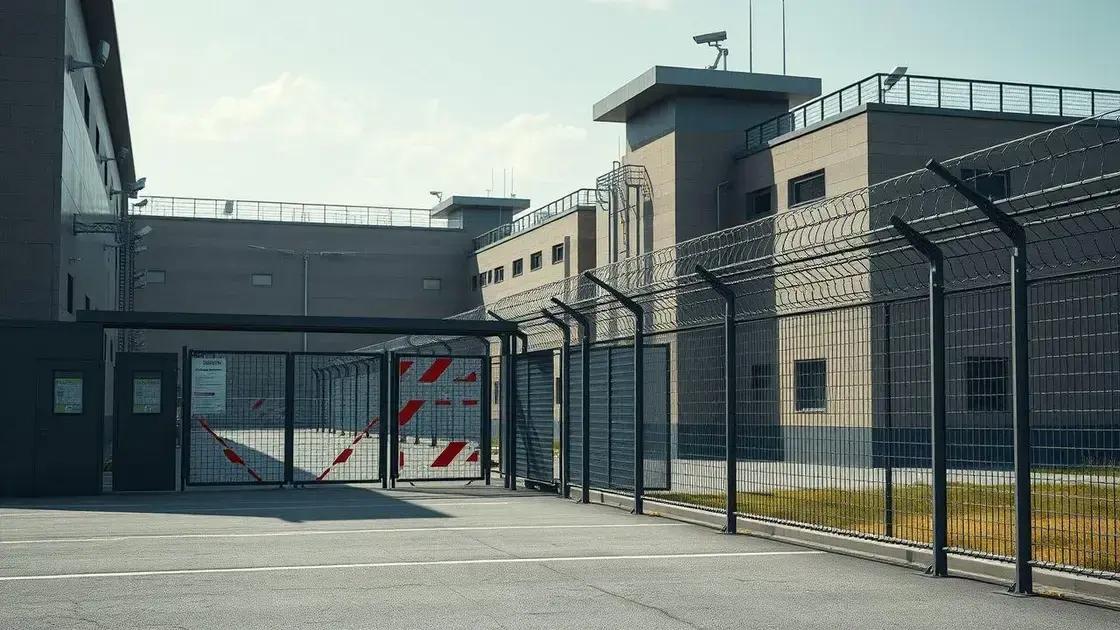A look inside El Salvador’s high-security CECOT prison

Anúncios
A look inside El Salvador’s high-security CECOT prison reveals its focus on reducing recidivism through education, vocational training, mental health support, and community connections, all aimed at aiding inmate reintegration into society.
A look inside El Salvador’s high-security CECOT prison uncovers not just its structure, but the human stories behind its walls. What makes this facility stand out in the realm of modern incarceration?
Anúncios
Overview of CECOT prison
The CECOT prison, located in El Salvador, represents a new era in prison architecture and management. This facility was designed to address the challenges posed by overcrowding and violence within the corrections system. As we explore the features of CECOT, we can gain insights into its operational strategies.
Key Features of CECOT Prison
Several aspects make CECOT unique:
Anúncios
- Advanced security measures
- Focus on inmate rehabilitation
- State-of-the-art infrastructure
- Innovative technology integration
These features are part of a broader strategy to create a safer environment for both inmates and staff. The design incorporates surveillance and controlled access points, which enhance security and minimize risks.
A noteworthy aspect of CECOT is the emphasis on treatment programs. Inmates have access to educational opportunities, vocational training, and therapeutic resources. By prioritizing rehabilitation, CECOT aims to reduce recidivism rates and help individuals reintegrate into society successfully.
Impact on Local Communities
The establishment of CECOT has had a significant impact on local communities. As a high-security facility, it aims to ensure that violent offenders are housed away from the general public. This separation helps to alleviate concerns about crime in nearby neighborhoods.
Furthermore, the prison has a role in community engagement, offering programs that allow inmates to participate in community service activities. This initiative not only benefits the community but also encourages inmates to give back and take responsibility for their actions.
Inmate management strategies
Effective inmate management strategies are crucial for maintaining safety and order within the CECOT prison. These strategies focus on enhancing inmate behavior and reducing conflicts. By implementing a structured approach, the facility aims to create a safer environment for both inmates and staff.
Key Strategies for Managing Inmates
Several strategies are used to manage inmates effectively:
- Behavioral observation and assessment
- Incentive programs for good behavior
- Conflict resolution training
- Regular mental health evaluations
Monitoring inmate behavior helps staff identify potential issues before they escalate. By understanding each inmate’s background and personality, officers can tailor their approach. This individual attention promotes a more positive atmosphere.
Another important aspect of managing inmates involves incentive programs. Inmates who exhibit good behavior may earn privileges, such as extra recreation time or access to educational resources. This creates a motivation for positive conduct and encourages inmates to engage in self-improvement.
Training for Staff
Investing in staff training is essential for the success of these management strategies. When staff are well-trained in communication and conflict resolution skills, they can handle challenging situations more effectively.
Moreover, regular mental health evaluations ensure that inmates receive the care they need. Addressing mental health concerns can reduce violent outbreaks and improve overall inmate behavior. By prioritizing mental well-being, CECOT fosters a more rehabilitative environment.
Impact of prison design on safety

The design of a prison plays a significant role in ensuring safety and security for both inmates and staff. At CECOT prison, several architectural features enhance safety and contribute to an overall secure environment.
Key Elements of Prison Design
Effective prison design includes:
- Maximum surveillance capability
- Segregation of violent offenders
- Controlled access points
- Strategic placement of staff
Surveillance is critical in maintaining order. CECOT incorporates advanced camera systems that allow for monitoring various areas of the facility. Such systems help identify potential issues before they escalate into violence. Inmates are also housed according to their behavior and risk levels, allowing for better control over violent offenders.
Additionally, the prison ensures that all access points are controlled. This minimizes the chances of unauthorized movement, enhancing overall safety. Staff placement is strategically planned as well, ensuring that personnel are readily available to respond to incidents when they arise.
Environmental Factors
The physical environment of CECOT also contributes to safety. Lighting, for example, is crucial in high-risk areas. Brightly lit environments deter inappropriate behavior and enhance visibility for staff.
Outdoor areas are designed to promote safe interactions among inmates while preventing opportunities for escape. Secure fencing and monitored recreation spaces allow inmates to engage in physical activity without compromising security. By creating a well-thought-out environment, CECOT effectively balances safety and inmate well-being.
Role of technology in prison operations
The role of technology in prison operations has increased significantly in recent years. At CECOT prison, various technological advancements help improve efficiency and enhance security. These innovations are key to modernizing correctional facilities.
Surveillance Technologies
One of the most crucial technologies is surveillance systems. CECOT uses advanced cameras that offer real-time monitoring of inmates and staff. This constant observation helps to prevent incidents before they occur. Additionally, these cameras can store footage for future review, which is important for investigations.
- 24/7 camera coverage
- Facial recognition capabilities
- Automatic alert systems for unusual behavior
Such sophisticated surveillance systems not only ensure safety but also instill a sense of accountability among inmates.
Communication Systems
Another key aspect is the communication systems installed within the prison. Staff can quickly relay information to each other using secure communication devices. This rapid communication is vital during emergencies, allowing for timely responses to incidents.
Additionally, inmates may have access to monitored communication tools that allow them to connect with family and legal representatives. These connections can support rehabilitation and provide emotional support, crucial for reducing recidivism.
Data Management
Data management systems are also a vital component of CECOT. These systems allow for the efficient tracking of inmate records, behavior patterns, and rehabilitation progress. By analyzing this data, staff can make informed decisions regarding individual treatment plans.
Overall, integrating technology into prison operations enhances safety, promotes better communication, and supports data-driven management strategies. These advancements contribute to creating a more efficient and secure environment for everyone involved.
Recidivism rates and rehabilitation programs
Recidivism rates are a significant concern in the prison system, and addressing them requires effective rehabilitation programs. At CECOT prison, various initiatives are implemented to help inmates reintegrate successfully into society.
Understanding Recidivism
Recidivism refers to the tendency of previously incarcerated individuals to reoffend and return to prison. Studies show that participation in rehabilitation programs can significantly reduce recidivism rates.
- Programs focused on education
- Vocational training opportunities
- Mental health support and counseling
- Substance abuse treatment
CECOT emphasizes educational programs, which play a crucial role in reducing recidivism. When inmates learn new skills, they increase their chances of securing employment once released. Vocational training equips inmates with practical skills, enabling them to find jobs that pay well and support their families.
The Importance of Support
In addition to education and vocational training, mental health support is essential for addressing underlying issues that may lead to reoffending. Inmates are provided with counseling services to help them manage stress, trauma, and other mental health challenges.
Substance abuse treatment is another vital component of rehabilitation. Many individuals struggle with addiction, which can lead to criminal behavior. CECOT offers programs that focus on recovery and help inmates develop healthy coping mechanisms.
Community Reintegration
Successful rehabilitation programs also emphasize the importance of community support. Establishing connections with family and local organizations can provide essential resources and encouragement for inmates upon release.
By focusing on education, mental health, and community connections, CECOT aims to reduce recidivism and promote successful reintegration into society. These comprehensive programs create opportunities for inmates to change their lives for the better, breaking the cycle of reoffending.
FAQ – Frequently Asked Questions about CECOT Prison and Rehabilitation Programs
What is the primary goal of rehabilitation programs at CECOT prison?
The primary goal is to reduce recidivism rates by providing inmates with education, vocational training, and mental health support.
How do educational programs impact recidivism?
Educational programs increase inmates’ chances of finding stable jobs upon release, which significantly helps reduce the likelihood of reoffending.
What type of mental health support is available at CECOT?
CECOT offers counseling services and therapy to help inmates manage mental health issues, which can contribute to their rehabilitation.
How does CECOT foster community connections for inmates?
The prison encourages family engagement and partnerships with local organizations to support inmates during their reintegration into society.






